How Tesla Uses Dashboards to Drive Innovation
 Mokkup
Mokkup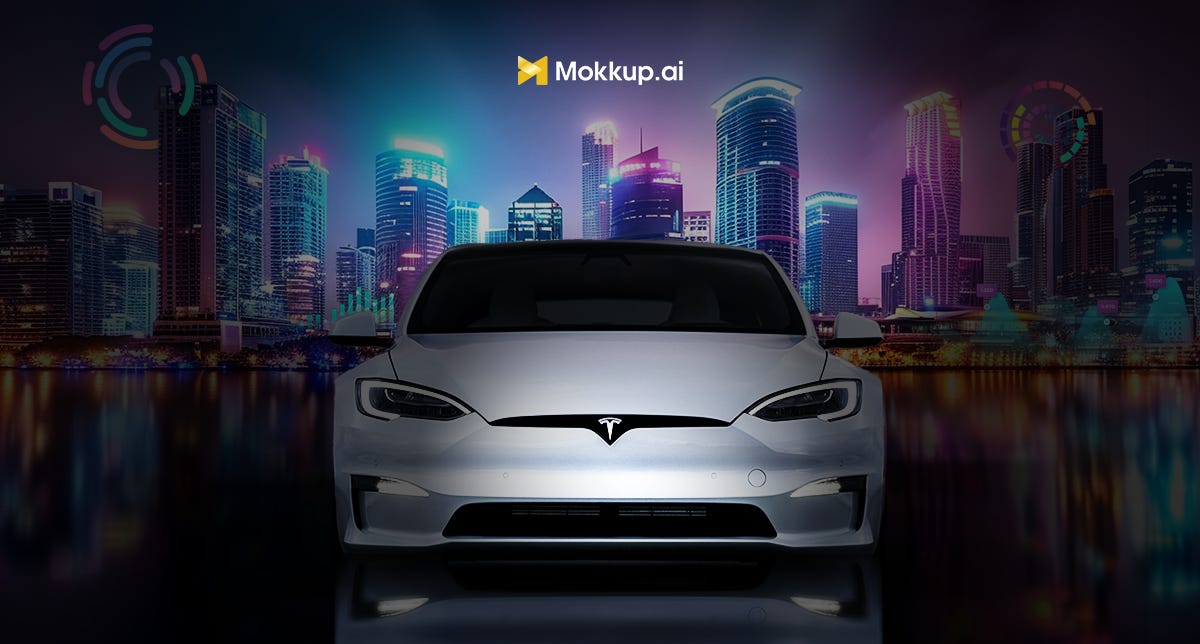
Tesla's Evolution and Vision
Tesla Inc., established in 2003, stands as a pioneer in the electric vehicle (EV) industry and a leading force in renewable energy solutions. Named after the visionary inventor Nikola Tesla, the company has transformed the automotive sector with its focus on electric powertrains, autonomous driving technologies, and sustainable energy production.
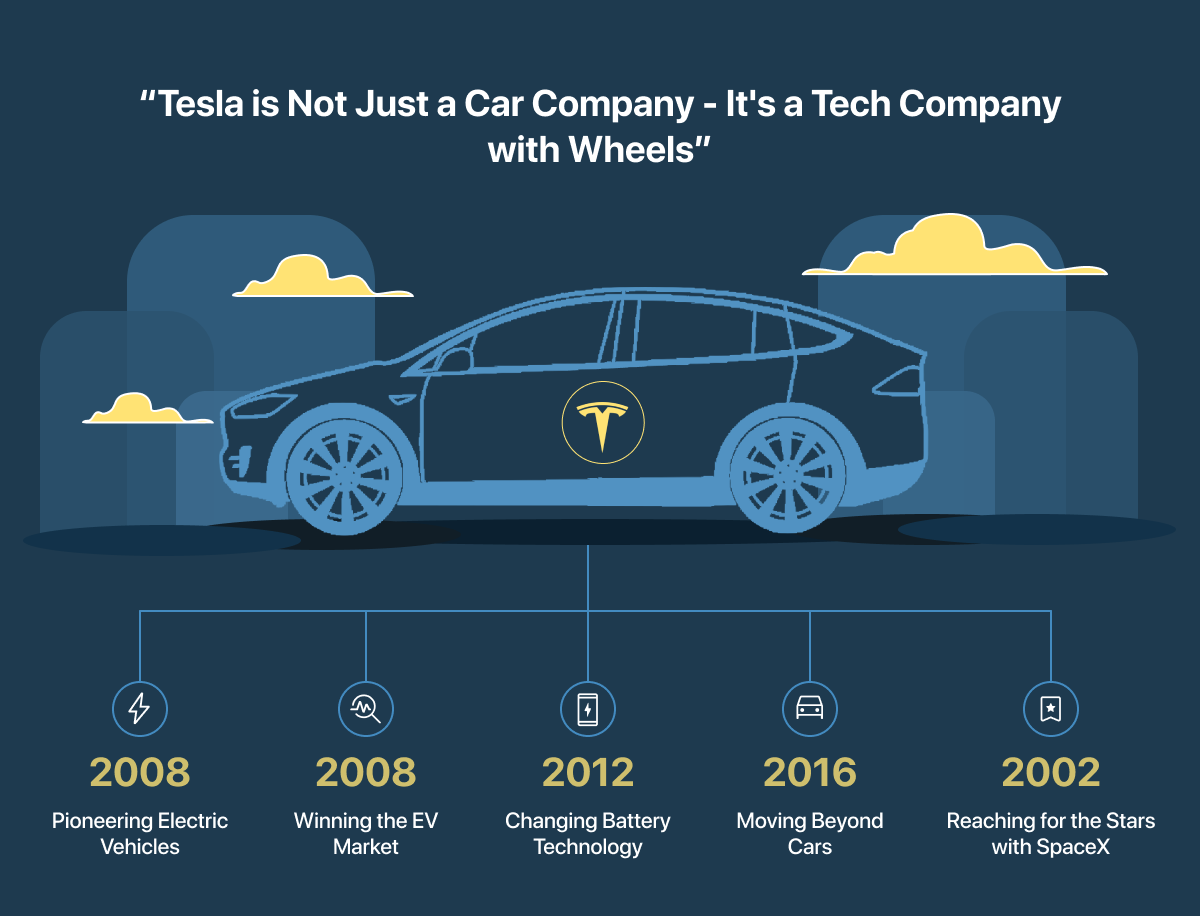
Founded by Martin Eberhard and Marc Tarpenning, Tesla received substantial initial funding from Elon Musk, who became CEO in 2008. Under Musk's leadership, Tesla has reached remarkable milestones:
Pioneering Electric Vehicles: In 2008, Tesla introduced its first automobile, the Roadster sports car, proving the viability and performance potential of EVs.
Winning the EV Market: Since its first car, the Roadster sports car launched in 2008, Tesla has steadily grown its presence in the EV market. Today, it offers a diversified portfolio of electric vehicles, including sedans (Model S launched in 2012, Model 3 launched in 2017), SUVs (Model X launched in 2015, Model Y launched in 2020), and trucks (Cybertruck unveiled in 2019 with production expected to begin in 2024), appealing to a wide range of consumer preferences.
Changing Battery Technology: Tesla has been a major force in battery innovation since its inception. Their extensive investment in battery research and development has resulted in significant improvements in car range and charging times. For example, the Model S initially offered a range of around 265 miles, but with continuous battery advancements, newer iterations can achieve over 400 miles on a single charge. Similarly, Tesla's Supercharger network, launched in 2012, has been continuously upgraded, allowing for faster charging times over the years.
Moving Beyond Cars: In 2016, Tesla acquired SolarCity, a leading developer of solar energy systems, demonstrating its dedication to sustainable energy solutions.
Reaching for the Stars with SpaceX: Elon Musk's vision goes beyond Tesla. He also co-founded SpaceX in 2002, a company dedicated to transforming space transportation with reusable rockets and spacecraft. SpaceX's Starship program aims to enable travel to Mars and beyond, pushing the boundaries of human exploration.
Tesla's commitment to innovation and data-driven decision-making has established it as a significant force in the global transition to electric mobility and renewable energy.
“Tesla is Not Just a Car Company - It's a Tech Company with Wheels”
Tesla's Data-Driven Approach
Tesla's dashboards gather a wide range of data, from detailed vehicle performance metrics to driving behaviors and fleet-wide trends. By effectively visualizing this information, Tesla obtains key insights that fuel ongoing advancement. Here's how Tesla uses dashboards to spur innovation:
Real-Time Feedback Loop
Tesla vehicles are like mobile data centers. A network of sensors constantly feeds information on everything from motor efficiency (important for maximizing a reported 350+ mile range in the Model S) to Autopilot performance.
Dashboards display this data in real-time, allowing engineers to identify issues and optimize systems remotely. This translates to faster repairs and improvements without requiring physical car check-ups.
Data-Driven Decisions
Imagine being able to observe exactly how drivers engage with your car's new features. Tesla's dashboards provide this visibility, allowing data-driven decisions about future designs and functionalities.
In Tesla's Gigafactories, these dashboards show real-time metrics on production rates, equipment efficiency, and failure rates. Managers and engineers may identify problems as they arise and make fast modifications, ensuring that production runs smoothly.
These dashboards also detect possible interruptions and equipment breakdowns before they happen, reducing downtime and increasing efficiency.
Over-the-Air Updates
Tesla's vehicles are like moving data collectors, loaded with sensors that constantly collect data on performance, usage trends, and potential problems. Tesla doesn't have to hold off until the next model year to address issues or increase performance.
They can utilize data from their dashboards to create software updates that can be distributed wirelessly throughout their automobiles. This keeps Teslas constantly improving and at the leading edge of technology.
This proactive approach maintains Tesla's safety and top performance. Additionally, by evaluating this data, they can alter future models, resulting in constant growth and creativity.
Predictive Maintenance
Tesla's influence goes beyond automobiles to the energy sector, including products such as the Powerwall and solar panels. Data dashboards are very important in this context. They track energy production, storage, and consumption in real-time, delivering insights that improve efficiency and dependability.
Dashboards, for example, monitor the performance of solar panels and energy storage devices, allowing for better maintenance planning and energy distribution. By evaluating consumption patterns and energy demand, Tesla ensures that its energy infrastructure runs at optimal efficiency, lowering costs and increasing sustainability.
Fleet Optimization
Tesla collects data not only on individual vehicles, but on their entire fleet. This enables them to improve everything from charging infrastructure to service center locations based on actual usage trends.
As of June 2023, Tesla had approximately 3700 Supercharger stations worldwide, strategically positioned based on anonymized driving data to provide easy long-distance travel for Tesla owners.
Transforming the Future of Autonomous Driving
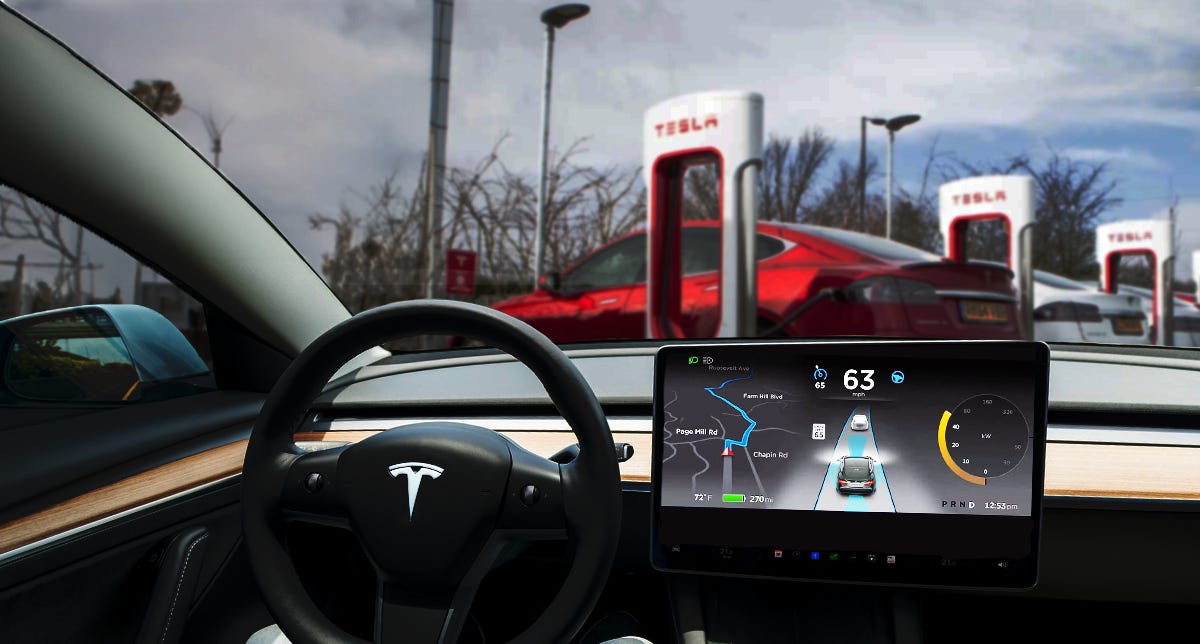
One of the most fascinating applications of Tesla's data dashboards is the development of autonomous driving technologies. Tesla receives massive amounts of data from its fleet equipped with Autopilot technology, which is then processed and shown on dashboards to help drive the development of its Full Self-Driving (FSD) system.
Tesla's dashboard approach illustrates how to use data to generate an endless cycle of innovation. By seeing and analyzing real-time data, they can discover problems, develop solutions, and quickly deploy them across their whole fleet. This data-driven strategy is a fundamental reason why Tesla continues to lead the electric vehicle revolution.
Tesla also uses this data to carry out experiments, testing how the system might react under various scenarios. This strategy accelerates development and constantly improves FSD technology using real-world data.
Dashboards That Can Elevate Your Business Performance
Organizations need more than just raw numbers to make informed decisions — they need intuitive and insightful dashboards. Effective dashboards transform complex data into easily understandable visuals, allowing stakeholders to quickly identify key metrics and trends.
By using well-designed dashboards, companies can enhance their strategic planning, streamline operations, and drive growth, ensuring they stay ahead in a competitive landscape. Here are a few examples for you.
Procurement Inventory Dashboard
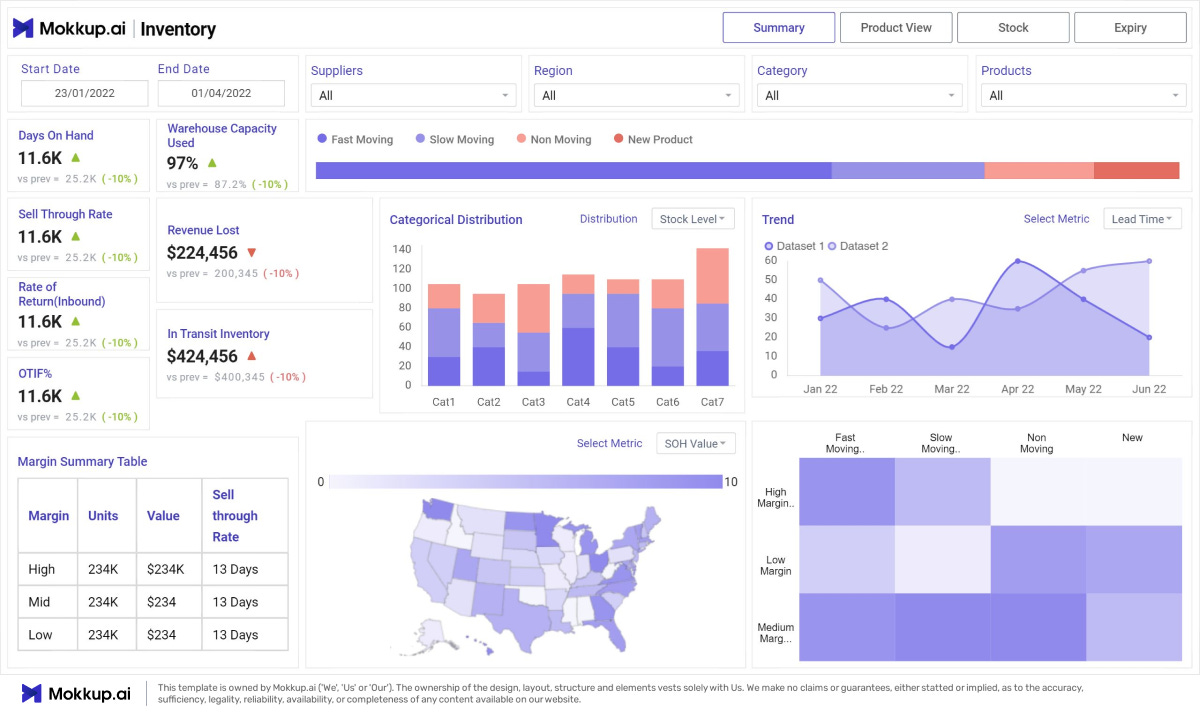
Procurement Inventory Dashboard on Mokkup.ai
A procurement inventory dashboard provides insights into procurement and inventory management. It allows businesses to maintain inventory levels, track order statuses, evaluate supplier performance, and analyze spending. By offering an in-depth overview of these key metrics, the dashboard helps companies maintain optimal stock levels, reduce costs, and improve overall supply chain efficiency.
Inventory Turnover Report
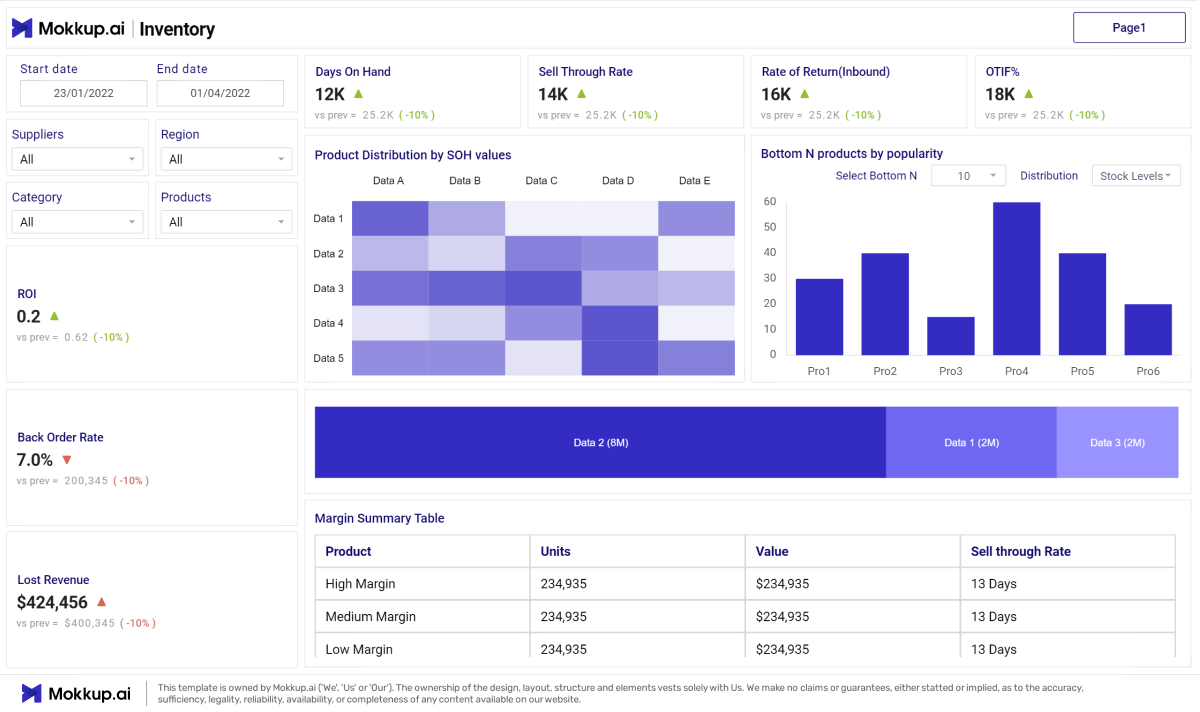
Inventory Turnover Report on Mokkup.ai
An inventory turnover report dashboard is an important tool for monitoring and analyzing how well a company maintains its inventory. This dashboard offers insights into inventory turnover rates, showing the frequency with which inventory is sold and replaced over a given time period.
The dashboard helps businesses optimize their inventory management, reduce holding costs, and improve overall operational efficiency.
Security Evaluation Report
A security evaluation report is used for monitoring and assessing the security record of an organization. It compiles essential security metrics and data into a clear visual format, providing insights into potential vulnerabilities, threat detection, compliance status, and incident response effectiveness.
By providing a comprehensive overview of these factors, the dashboard enables businesses to quickly identify and mitigate security issues, ensuring strong asset and data protection.
Conclusion
Tesla's strategic use of data dashboards shows how data-driven decision-making can foster innovation and maximize productivity. By using real-time data across its automotive, energy, and space endeavors, Tesla not only enhances its product performance and customer experience but also excels in advancements in technology and sustainability.
The company's ability to transform complex data into meaningful insights allows it to constantly improve its offers, manage operations, and maintain a competitive advantage. As Tesla continues to push the boundaries of what is possible, its approach to data dashboards offers a model for organizations looking to maximize the value of their data and make significant progress.
Sign up on Mokkup.ai for free and start creating high-fidelity dashboard wireframes in under 30 minutes!
Subscribe to my newsletter
Read articles from Mokkup directly inside your inbox. Subscribe to the newsletter, and don't miss out.
Written by

Mokkup
Mokkup
Mokkup.ai is a dashboard wireframing tool that helps you create dashboard wireframes in less than 30 minutes. Try for free!